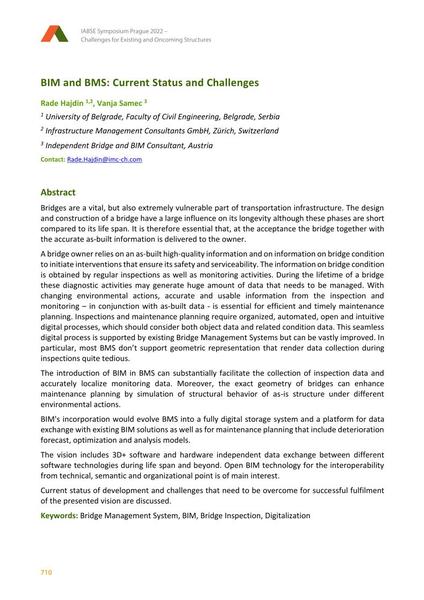BIM and BMS: Current Status and Challenges

|
|
|||||||||||
Bibliographic Details
| Author(s): |
Rade Hajdin
Vanja Samec (Independent Bridge and BIM Consultant, Austria) |
||||
|---|---|---|---|---|---|
| Medium: | conference paper | ||||
| Language(s): | English | ||||
| Conference: | IABSE Symposium: Challenges for Existing and Oncoming Structures, Prague, Czech Republic, 25-27 May 2022 | ||||
| Published in: | IABSE Symposium Prague 2022 | ||||
|
|||||
| Page(s): | 710-715 | ||||
| Total no. of pages: | 6 | ||||
| DOI: | 10.2749/prague.2022.0710 | ||||
| Abstract: |
Bridges are a vital, but also extremely vulnerable part of transportation infrastructure. The design and construction of a bridge have a large influence on its longevity although these phases are short compared to its life span. It is therefore essential that, at the acceptance the bridge together with the accurate as-built information is delivered to the owner. A bridge owner relies on an as-built high-quality information and on information on bridge condition to initiate interventions that ensure its safety and serviceability. The information on bridge condition is obtained by regular inspections as well as monitoring activities. During the lifetime of a bridge these diagnostic activities may generate huge amount of data that needs to be managed. With changing environmental actions, accurate and usable information from the inspection and monitoring – in conjunction with as-built data - is essential for efficient and timely maintenance planning. Inspections and maintenance planning require organized, automated, open and intuitive digital processes, which should consider both object data and related condition data. This seamless digital process is supported by existing Bridge Management Systems but can be vastly improved. In particular, most BMS don’t support geometric representation that render data collection during inspections quite tedious. The introduction of BIM in BMS can substantially facilitate the collection of inspection data and accurately localize monitoring data. Moreover, the exact geometry of bridges can enhance maintenance planning by simulation of structural behavior of as-is structure under different environmental actions. BIM's incorporation would evolve BMS into a fully digital storage system and a platform for data exchange with existing BIM solutions as well as for maintenance planning that include deterioration forecast, optimization and analysis models. The vision includes 3D+ software and hardware independent data exchange between different software technologies during life span and beyond. Open BIM technology for the interoperability from technical, semantic and organizational point is of main interest. Current status of development and challenges that need to be overcome for successful fulfilment of the presented vision are discussed. |
||||
| Keywords: |
bridge Inspection BIM bridge management system digitalization
|
||||
| Copyright: | © 2022 International Association for Bridge and Structural Engineering (IABSE) | ||||
| License: | This creative work is copyrighted material and may not be used without explicit approval by the author and/or copyright owner. |
||||
